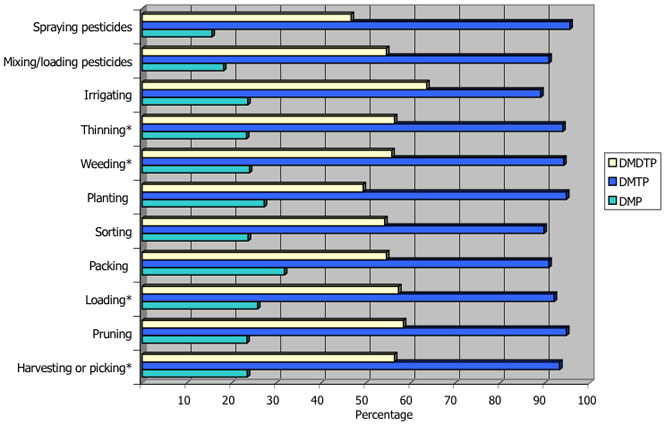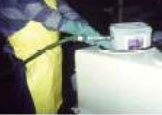Chemical Contact
Skin Irritation – Second most frequent work-related injury complaint by orchard harvesters.
Chemicals – 5% of occupational health visits.
Difficulties in diagnosing chemicals include:
- Nonspecific symptoms
- Patients lack of chemicals knowledge.
Important on-site requirements for growers that can help you with diagnosis and treatment:
- Chemical information should be posted in the field in a central location.
- A decontamination site for chemical handlers is required.
- Information on chemicals to farmworkers and their care-givers is mandatory.
- Growers need to conform to REI (Restricted Entry Interval) recommendations:
- Generally the REI is 12 hours
- For chemicals with a Caution label the REI is 24 hours
- For chemicals with a Danger label the REI is 48 hours
- This is a general rule and some exceptions do exist.
Chemicals of Washington State Farmworkers by Job Task
- Primary crops are apples, cherries, grapes, hops, peaches and pears
- Association between occupational task and organophosphate (OP) metabolic concentrations in urine samples and OP chemical residues in dust were determined in 211 farmworkers and
their homes - 50 % of population is Hispanic
Percent detectable dimethyl urinary metabolites among adult farmworkers

Tasks with an asterix (*) indicate those jobs that workers spent over 40% of their time involved in:
- The graph above was developed after collecting 2 or 3 urine samples from each farmworker
over a 2-week period. - The samples were analyzed to detect 3 different compounds produced by the metabolism of
most OP chemicals: dimethylphosphate (DMP), dimethylthiophosphate (DMTP), and
dimethyldithiophosphate (DMDTP).
Chemicals Study Findings

- The proportion of detectable levels of DMP among workers who performed fieldwork was greater compared to workers who mixed, loaded, or applied chemicals
- Workers who mixed, loaded, or applied chemicals had significantly less chemical residues in their vehicles and homes
- Workers performing fieldwork are not required to wear gloves and other protective equipment like workers that mix, load, or apply chemicals.
- Workers who thin are at high risk for greater proportions of dimethyl urinary metabolites as they are allowed to work on the crops 7 days after OP chemicals are applied, which is 7 days before all other workers can begin their work.
- Thinners have significantly higher levels of chemical residues in their vehicles and homes.

- Children of thinners exhibited greater proportion of dimethyl urinary metabolites than children of other workers.
Conclusions
- All farmworkers are at risk for chemicals so it is very important to wear gloves, hats, and other protective equipment
- The levels of personal exposure to chemicals may directly effect the concentration of chemicals in the home environment and the risk of exposure of family members
Chemical Resources
Chemical Action Network (PAN) Database:
General resources:
- National Pesticide Information Center (NPIC) – NPIC Hotline: 1-800-858-7378
- The National Environmental Education and
Training Foundation (NEETF) - Pesticides Resource Library
- Pesticides Resources Inventory
- Environmental Protection Agency: Pesticides
Environmental Protection Agency’s Pesticide Poisoning Handbook
Recognition and Management of Pesticide Poisonings, by J. Routt Reigart and James R. Roberts.
Available online
